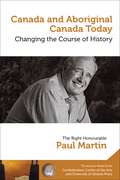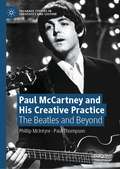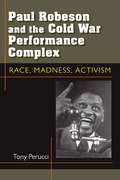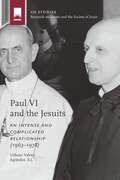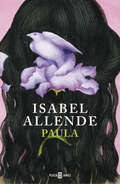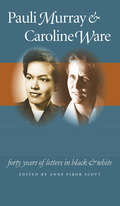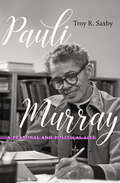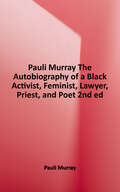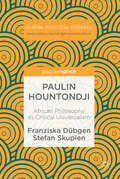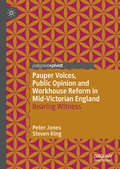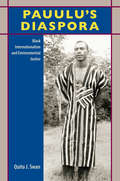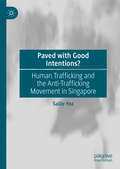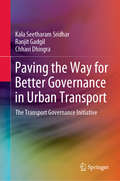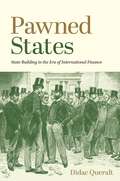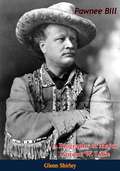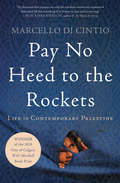- Table View
- List View
Paul Martin: Changing the Course of History - Changer le cours de l’histoire (The Symons Medal Series / Collection de la médaille Symons #1)
by Paul MartinIn his 2013 Symons Medal lecture, the Right Honourable Paul Martin, the twenty-first prime minister of Canada, brings to bear all the knowledge and experience of his remarkable public career to explain the challenge of achieving justice for the Aboriginal peoples of Canada. Exploring both historic roots and current priorities, Mr. Martin argues self-government is an essential condition for Canada’s Aboriginal peoples, but must be accompanied by adequate funding. Above all, he issues an urgent, eloquent and deeply informed call to action, calling on Canadians to exercise, today, the same kind of imagination, generosity and courage that the Fathers of Confederation showed, when they met at Charlottetown, in 1864.Canada and Aboriginal Canada Today: Changing the Course of History is a vitally important contribution to the ongoing debate about the role of Canada’s aboriginal peoples in the Canada of today and tomorrow. It is essential reading for all Canadians who want to learn about the historic roots of current challenges, and to reflect upon the issues of justice and equality for Canada’s Aboriginal peoples today. The Symons Medal, one of Canada’s most prestigious honours, is presented annually by the Confederation Centre of the Arts, Canada’s national memorial to the Fathers of Confederation, to honour persons who have made an exceptional and outstanding contribution to Canadian life. This book is bilingual. The Right Honourable Paul Martin, 21st prime minister of Canada, discusses the challenge of achieving justice for the Aboriginal peoples of Canada. Bilingual English-French turn-around book. Bilingual Edition.
Paul McCartney and His Creative Practice: The Beatles and Beyond (Palgrave Studies in Creativity and Culture)
by Paul Thompson Phillip McIntyreThis book provides fresh insight into the creative practice developed by Paul McCartney over his extended career as a songwriter, record producer and performing musician. It frames its examination of McCartney’s work through the lens of the systems model of creativity developed by Mihaly Csikszentmihalyi and combines this with the research work of Pierre Bourdieu. This systems approach is built around the basic structures of idiosyncratic agents, like McCartney himself, and the choices he has made as a creative individual. It also locates his work within social fields and cultural domains, all crucial aspects of the creative system that McCartney continues to be immersed in. Using this tripartite system, the book includes analysis of McCartney’s creative collaborations with musicians, producers, artists and filmmakers and provides a critical analysis of the Romantic myth which forms a central tenet of popular music. This engaging work will have interdisciplinary appeal to students and scholars of the psychology of creativity, popular music, sociology and cultural studies.
Paul Merker, the GDR, and the Politics of Memory: ‘Purging Cosmopolitanism’?
by Alexander D. BrownThis book presents ground-breaking research into the ‘Merker affair,’ a series of events that took place in the German Democratic Republic (GDR) in the early 1950s, which saw Paul Merker, a member of the ruling party’s ‘Politburo,’ become ensnared in the agent hysteria of the period. He was ultimately deposed, arrested, and convicted on charges of espionage. However, the cultural significance of this affair goes far beyond the history of the early Cold War; it has become the definitive symbol of alleged antisemitism in the GDR. The narrative complex of an antisemitic GDR has in turn become a prominent topos within the politics of memory in Germany. The author combines an empirical study of the pertinent primary sources with a genealogical analysis of discourse on the Merker affair in order to question and historicise many of the entrenched historiographical tropes surrounding it, and indeed broader subjects such as antifascism and antisemitism in a German context. In doing so, the book offers insight into how German state-mandated institutions and official bodies have shaped our collective vision of the past.
Paul Revere and the Bell Ringers (Ready-to-read Level 2)
by Jonah WinterYoung Paul Revere and his friends form a club whose members ring the bells at Christ Church, an experience which teaches him responsibility and other lessons that he uses as an adult in the American Revolution.
Paul Robeson and the Cold War Performance Complex
by Tony PerucciActor and singer Paul Robeson's performances inOthello,Show Boat, andThe Emperor Jonesmade him famous, but his midcentury appearances in support of causes ranging from labor and civil rights to antilynching and American warmongering made him notorious. When Robeson announced at the 1949 Paris Peace Conference that it was "unthinkable" for blacks to go to war against the Soviet Union, the mainstream American press declared him insane. Notions of Communism, blackness, and insanity were interchangeably deployed during the Cold War to discount activism such as Robeson's, just a part of an array of social and cultural practices that author Tony Perucci calls the Cold War performance complex. Focusing on two key Robeson performances---the concerts in Peekskill, New York, in 1949 and his appearance before the House Committee on Un-American Activities in 1956---Perucci demonstrates how these performances and the government's response to them are central to understanding the history of Cold War culture in the United States. His book provides a transformative new perspective on how the struggle over the politics of performance in the 1950s was also a domestic struggle over freedom and equality. The book closely examines both of these performance events as well as artifacts from Cold War culture---including congressional documents, FBI files, foreign policy papers, the popular literature on mental illness, and government propaganda films---to study the operation of power and activism in American Cold War culture.
Paul VI and the Jesuits: An Intense and Complicated Relationship (1963-78)
by Urbano Valero Agúndez S.J.Now available for the first time in English, Paul VI and the Jesuits is the compelling and previously untold story of the intense and complicated relationship between Pope Paul VI and the Society of Jesus. Written by Fr. Urbano Valero Agúndez, S.J., with critical editing by Thomas McCoog, S.J., this historical reconstruction sheds light on the inner workings of the Society of Jesus during a transformative period in Catholic history. Through meticulous research, Valero has pieced together a well-documented narrative that offers readers a never-before-seen glimpse into the dynamic relationship between the Pope and the Society of Jesus. “This is a major contribution to our understanding of the dynamic of the Holy See and the Society as the Church tried to grapple with what amounted to a cultural revolution in Catholicism in the 1960s and 1970s.” —Oliver P. Rafferty, S.J., Professor of History, Boston College
Paul Virilio (Routledge Critical Thinkers)
by Ian JamesPaul Virilio is a challenging and original thinker whose work on technology, state power and war is increasingly relevant today. Exploring Virilio's main texts from their political and historical contexts, and case studies from contemporary culture and media in order to explain his philosophical concepts, Ian James introduces the key themes in Virlio's work, including: speed virtualization war politics art. As technological and scientific innovations continue to set the agenda for the present and future development of culture, communications, international economy, military intervention and diverse forms of political organization, Virilio's unique theoretical and critical insights are of enormous value and importance for anyone wishing to understand the nature of modern culture and society.
Paula
by Isabel AllendeCualquier libro de Isabel Allende es un acontecimiento. Paula lo es especialmente porque se trata del más conmovedor, personal e íntimo de todos los libros que ha publicado hasta la fecha. Cuando la gran autora chilena se encontraba en España con ocasión de la presentación de El plan infinito, su hija Paula entró en estado de coma. Junto al lecho de Paula, mientras seguía con angustia la evolución de su enfermedad, Isabel Allende comenzó a redactar en un cuaderno la historia de su familia y de sí misma con el propósito de regalársela a su hija una vez superara el dramático trance. Sin embargo, éste se prolongó durante meses y los apuntes de la autora acabaron convirtiéndose en un libro apasionante y revelador. Isabel Allende ejerce aquí su prodigioso talento narrativo para recuperar y asumir sus propias vivencias como mujer y como escritora, así como las de su familia y las de la historia reciente de su país. Autorretrato de insólita emotividad al tiempo que exquisitarecreación de la sensibilidad de las mujeres de nuestra época, Paula perdura en el ánimo del lector con la intensidad de una experiencia indeleble.
Pauli Murray and Caroline Ware
by Anne Firor ScottIn 1942 Pauli Murray, a young black woman from North Carolina studying law at Howard University, visited a constitutional law class taught by Caroline Ware, one of the nation's leading historians. A friendship and a correspondence began, lasting until Murray's death in 1985. Ware, a Boston Brahmin born in 1899, was a scholar, a leading consumer advocate, and a political activist. Murray, born in 1910 and raised in North Carolina, with few resources except her intelligence and determination, graduated from college at 16 and made her way to law school, where she organized student sit-ins to protest segregation. She pulled her friend Ware into this early civil rights activism. Their forty-year correspondence ranged widely over issues of race, politics, international affairs, and--for a difficult period in the 1950s--McCarthyism.In time, Murray became a labor lawyer, a university professor, and the first black woman to be ordained an Episcopal priest. Ware continued her work as a social historian and consumer advocate while pursuing an international career as a community development specialist. Their letters, products of high intelligence and a gift for writing, offer revealing portraits of their authors as well as the workings of an unusual female friendship. They also provide a wonderful channel into the social and political thought of the times, particularly regarding civil rights and women's rights.In 1942 Pauli Murray, a young black woman from North Carolina studying law at Howard University, visited a constitutional law class taught by Caroline Ware, one of the nation's leading historians. A friendship and a correspondence began, lasting until Murray's death in 1985. Their forty-year correspondence ranged widely over issues of race, politics, international affairs, and--for a difficult period in the 1950s--McCarthyism.In time, Murray became a labor lawyer, a university professor, and the first black woman to be ordained an Episcopal priest. Ware continued her work as a social historian and consumer advocate while pursuing an international career as a community development specialist. Their letters, products of high intelligence and a gift for writing, offer revealing portraits of their authors as well as the workings of an unusual female friendship. They also provide a wonderful view of the social and political thought of the times, particularly regarding civil rights and women's rights.Anne Firor Scott is recipient of a 2008 American Historical Association Award for Scholarly Distinction.-->
Pauli Murray: A Personal and Political Life
by Troy R. SaxbyThe Rev. Dr. Anna Pauline "Pauli" Murray (1910–1985) was a trailblazing social activist, writer, lawyer, civil rights organizer, and campaigner for gender rights. In the 1930s and 1940s, she was active in radical left-wing political groups and helped innovate nonviolent protest strategies against segregation that would become iconic in later decades, and in the 1960s, she cofounded the National Organization for Women (NOW). In addition, Murray became the first African American to receive a Yale law doctorate and the first black woman to be ordained an Episcopal priest. Yet, behind her great public successes, Murray battled many personal demons, including bouts of poor physical and mental health, conflicts over her gender and sexual identities, family traumas, and financial difficulties. In this intimate biography, Troy Saxby provides the most comprehensive account of Murray's inner life to date, revealing her struggles in poignant detail and deepening our understanding and admiration of her numerous achievements in the face of pronounced racism, homophobia, transphobia, and political persecution. Saxby interweaves the personal and the political, showing how the two are always entwined, to tell the life story of one of twentieth-century America's most fascinating and inspirational figures.
Pauli Murray: The Autobiography of a Black Activist, Feminist, Lawyer, Priest, and Poet
by Pauli MurrayPauli Murray (1910-1985) is regarded as "one of the least discussed figures in the history of twentieth-century African American women's activism." She was a highly regarded Feminist, who called attention to the plight of women, especially the colored and working poor. Roy Wilson
Paulin Hountondji: African Philosophy as Critical Universalism (Global Political Thinkers)
by Franziska Dübgen Stefan SkupienPaulin J. Hountondji is one of the most important and controversial figures in contemporary African philosophy. His critique of ethnophilosophy as a colonial, exoticising and racialized undertaking provoked contentious debates among African intellectuals on the proper methods and scope of philosophy and science in an African and global context since the 1970s. His radical pledge for scientific autonomy from the global system of knowledge production made him turn to endogenous forms of practising science in academia. The horizon of his philosophy is the quest for critical universality from a historical, and situated perspective. Finally, his call for a notion of culture that is antithetical to political movements focused on a single identitarian doctrine or exclusionary norms shows how timely his political thought remains to this day. This book gives a comprehensive overview of Hountondji’s philosophical arguments and provides detailed information on the historical and political background of his intellectual oeuvre. It situates Hountondji in the dialogue with his African colleagues and explores links to current debates in philosophy, cultural studies, postcolonialism and the social sciences.
Pauline Tarnowsky's Les Femmes Homicides: Part I (Routledge Studies in Crime and Society)
by Boniface Noyongoyo Lin Huff-Corzine Kayla ToohyTranslated by Kayla Toohy and Boniface NoyongoyoThis translation of Les Femmes Homicides, by Praskov’ia Tarnovskaia, or Pauline Tarnowsky as her name has been Westernized, presents an important historical work in English for the first time. Tarnowsky, a neuropathologist and one of the first women allowed to attend medical school in Russia, has been called by some as the “first woman criminologist.” In Les Femmes Homicides, she uses a sample of rural peasant women who had committed homicide to test the “born criminal theory” often associated with Cesare Lombroso and to expand the theoretical explanations for the women’s homicides to include heredity and social impacts. This first volume includes Tarnowsky’s theory, methodology, and the first two categories of women she studied who were incarcerated for homicide.Tarnowsky’s progression from the original endeavor of identifying born criminals based on physical characteristics to the assertions she makes on the influences of biological and social factors are progressive for her time and an important contribution to the development of the discipline. Her meticulous methodological and extensive theoretical considerations regarding the intersections of her criminal population (e.g., race, environment, time, place, unity, and other social conditions) make this one of the first comprehensive studies on female offenders to use a control group to make comparisons among consistently homogenous criminal and non-criminal populations. She calls upon what we now know as the social sciences to study and explain homicides committed by women, eventually denouncing the importance of Lombroso’s theory of “born criminals.” Some images of the women of Les Femmes Homicides can be found on the online book page at www.Routledge.com.This historical work is essential reading for scholars and students engaged in criminology, homicide studies, social history, history of criminological ideas, criminal law, social sciences, and gender studies.
Pauper Voices, Public Opinion and Workhouse Reform in Mid-Victorian England: Bearing Witness
by Peter Jones Steven KingThis book represents the first attempt to identify and describe a workhouse reform ‘movement’ in mid- to late-nineteenth-century England, beyond the obvious candidates of the Workhouse Visiting Society and the voices of popular critics such as Charles Dickens and Florence Nightingale. It is a subject on which the existing workhouse literature is largely silent, and this book therefore fills a considerable gap in our understanding of contemporary attitudes towards institutional welfare. Although many scholars have touched on the more obvious strands of workhouse criticism noted above, few have gone beyond these to explore the possibility that a concerted ‘movement’ existed that sought to place pressure on those with responsibility for workhouse administration, and to influence the trajectory of workhouse policy.
Pauulu’s Diaspora: Black Internationalism and Environmental Justice
by Quito J. SwanChoice Outstanding Academic TitleFinalist, Association for the Study of African American Life and History Book Prize Honorable Mention, Organization of American Historians Liberty Legacy Foundation Award A Black Perspectives Best Black History Book of 2020 Winner of the African American Intellectual History Society Pauli Murray Book PrizeBermuda Literary Awards Dr. Eva Hodgson Prize for Non-Fiction Pauulu’s Diaspora is a sweeping story of black internationalism across the Atlantic, Indian, and Pacific Ocean worlds, told through the life and work of twentieth-century environmental activist Pauulu Kamarakafego. Challenging U.S.-centered views of Black Power, Quito Swan offers a radically broader perspective, showing how Kamarakafego helped connect liberation efforts of the African diaspora throughout the Global South. Born in Bermuda and with formative experiences in Cuba, Kamarakafego was aware at an early age of the effects of colonialism and the international scope of racism and segregation. After pursuing graduate studies in ecological engineering, he traveled to Africa, where he was inspired by the continent’s independence struggles and contributed to various sustainable development movements. Swan explores Kamarakafego’s remarkable fusion of political agitation and scientific expertise and traces his emergence as a central coordinator of major black internationalist conferences. Despite government surveillance, Kamarakafego built a network of black organizers that reached from Kenya to the islands of Oceania and included such figures as C. L. R. James, Queen Mother Audley Moore, Kwame Nkrumah, Sonia Sanchez, Sylvia Hill, Malcolm X, Vanessa Griffen, and Stokely Carmichael. In a riveting narrative that runs through Caribbean sugarcane fields, Liberian rubber plantations, and Papua New Guinean rainforests, Pauulu’s Diaspora recognizes a global leader who has largely been absent from scholarship. In doing so, it brings to light little-known relationships among Black Power, pan-Africanism, and environmental justice.
Paved with Good Intentions?: Human Trafficking and the Anti-trafficking Movement in Singapore
by Sallie YeaThis book focuses on human trafficking and the anti-trafficking movement, particularly as it is expressed in Southeast Asia. The study is based on ethnographic research of the emerging anti-trafficking movement in Singapore, and in-depth interviews and observations with victims of human trafficking and others subject to labour exploitation in Singapore. Research in the book adds to the significant amount of work documenting human trafficking in Asia, by offering a critical academic perspective on the rise of the anti-trafficking movement. Readers will gain an understanding of how anti-trafficking operates as a new social movement and state practice, and how anti-trafficking often sits at odds with the experiences of trafficked and exploited persons themselves.
Paving the Way for Better Governance in Urban Transport: The Transport Governance Initiative
by Ranjit Gadgil Chhavi Dhingra Kala Seetharam SridharThis book presents an innovative democratic framework that ensures public participation, based on applying principles of good governance to facilitate urban transport decision-making in an integrated and structured manner. While – given the need for mobility in cities – transport is crucial for urban development, problems such as the fragmentation of institutions, decision-making, and unequal knowledge concentrations represent major hurdles to effective governance outcomes (especially those that go beyond technical and regulatory aspects). Substantial investments continue to be pumped into the urban transportation sector, with cities lacking the necessary capacities or governance mechanisms to ensure optimal returns on these investments. The book introduces the transport governance framework, which is intended to provide an integrated and structured approach to facilitate decision-making processes in the urban transport sector, focusing on how decisions are made rather than what decisions are made. It also discusses the initial testing of the framework in several cities across India. In addition, it examines the application of the TAPC (transparency, accountability, participation, and capacity building) principles of good governance to key aspects of urban transport – policy, planning, standards, budgets, execution, and regulation.
Paving the Way: The First American Women Law Professors (Law in the Public Square #1)
by Herma Hill KayThe first wave of trailblazing female law professors and the stage they set for American democracy. When it comes to breaking down barriers for women in the workplace, Ruth Bader Ginsburg’s name speaks volumes for itself—but, as she clarifies in the foreword to this long-awaited book, there are too many trailblazing names we do not know. Herma Hill Kay, former Dean of UC Berkeley School of Law and Ginsburg’s closest professional colleague, wrote Paving the Way to tell the stories of the first fourteen female law professors at ABA- and AALS-accredited law schools in the United States. Kay, who became the fifteenth such professor, labored over the stories of these women in order to provide an essential history of their path for the more than 2,000 women working as law professors today and all of their feminist colleagues. Because Herma Hill Kay, who died in 2017, was able to obtain so much first-hand information about the fourteen women who preceded her, Paving the Way is filled with details, quiet and loud, of each of their lives and careers from their own perspectives. Kay wraps each story in rich historical context, lest we forget the extraordinarily difficult times in which these women lived. Paving the Way is not just a collection of individual stories of remarkable women but also a well-crafted interweaving of law and society during a historical period when women’s voices were often not heard and sometimes actively muted. The final chapter connects these first fourteen women to the "second wave" of women law professors who achieved tenure-track appointments in the 1960s and 1970s, carrying on the torch and analogous challenges. This is a decidedly feminist project, one that Justice Ruth Bader Ginsburg advocated for tirelessly and admired publicly in the years before her death.
Pawned States: State Building in the Era of International Finance (The Princeton Economic History of the Western World #110)
by Didac QueraltHow foreign lending weakens emerging nationsIn the nineteenth century, many developing countries turned to the credit houses of Europe for sovereign loans to balance their books and weather major fiscal shocks such as war. This reliance on external public finance offered emerging nations endless opportunities to overcome barriers to growth, but it also enabled rulers to bypass critical stages in institution building and political development. Pawned States reveals how easy access to foreign lending at early stages of state building has led to chronic fiscal instability and weakened state capacity in the developing world.Drawing on a wealth of original data to document the rise of cheap overseas credit between 1816 and 1913, Didac Queralt shows how countries in the global periphery obtained these loans by agreeing to “extreme conditionality,” which empowered international investors to take control of local revenue sources in cases of default, and how foreclosure eroded a country’s tax base and caused lasting fiscal disequilibrium. Queralt goes on to combine quantitative analysis of tax performance between 1816 and 2005 with qualitative historical analysis in Latin America, Asia, Africa, and the Middle East, illustrating how overreliance on external capital by local leaders distorts their incentives to expand tax capacity, articulate power-sharing institutions, and strengthen bureaucratic apparatus.Panoramic in scope, Pawned States sheds needed light on how early and easy access to external finance pushes developing nations into trajectories characterized by fragile fiscal institutions and autocratic politics.
Pawnee (The Native Americans)
by Barbara A. Gray-KanatiioshAn introduction to the history, social life, customs, and present life of the Pawnee Indians.
Pawnee Bill: A Biography of Major Gordon W. Lillie
by Glenn ShirleyOriginally published in 1958, this is the biography of Major Gordon W. Lillie, known as “Pawnee Bill,” one of the last of the “hardy band of heroes in buckskin who opened up the West.”Lillie made his way into Indian Territory while working as a trapper with “Trapper Tom” McClain’s outfit, waiting tables, and working as a cowboy. He served as a teacher at the Pawnee agency and was also appointed as interpreter and secretary to Maj. Edward Bowman, U.S. Indian agent. During this time he became known as “Pawnee Bill.”“[…] he early was attracted by the free outdoor life of the great Western plains and, before he came of age, he had joined other famous characters of the time in various enterprises, including the lucrative business of shooting buffalo for their hides and trapping the varied and plentiful fur-bearing animals whose skins brought fancy prices in the Eastern markets and in London.“Widely known as a showman, a teacher and friend of the Indian and finally as a colonizer in Oklahoma and builder of his state, he toured the country and the world, first alone, then in partnership with Colonel William F. (“Buffalo Bill”) Cody, with a Wild West show that had no equal. Its wild Indians were terrifying, its horsemen were death-defying, and not the least of its attractions was Pawnee Bill, wearing long, flowing hair and buckskin, who, from horseback, plugged glass balls in mid-air with six-shooter and Winchester.”“He lived […] a life not only colorful but of material aid in the development of the West. His was a story book existence come true, and he will long remain a small boy’s hero in fact and legend.”
Pax Americana: Unending War on Iraq (Frontiers of Globalization)
by Jacqueline S. Ismael Tareq Y. Ismael Leslie T. MacDonaldThis book surveys the testimony of international organizations of the impact of American foreign policy on Iraq. Each reveals a fragment of Iraq’s mosaic of misery and desolation, but lacks the context to permit our understanding why this has happened. A parallel lack of context characterizes most of the political commentary, overlooking the recurring pattern of victimization of Iraqis, regardless of which political party controls the White House. This book takes a broader perspective, to reveal the enduring pattern linking specific events.
Pax Ethnica: Where and How Diversity Succeeds
by Karl E. Meyer Shareen Blair BrysacIn a world replete with stories of sectarian violence, we are often left wondering: Are there places where people of different ethnicities, especially with significant Muslim minorities, live in peace? If so, why havenOCOt we heard more about them, and what explains their success? To answer these questions, Karl Meyer and Shareen Brysac undertook a two-year exploration of oases of civility, places notable for minimal violence, rising life-expectancy, high literacy, and pragmatic compromises on cultural rights. They explored the Indian state of Kerala, the Russian republic of Tatarstan, the city of Marseille in France, the city of Flensburg, Germany, and the borough of Queens, New York. Through scores of interviews, they document ways and means that have proven successful in defusing ethnic tensions. This pathbreaking book elegantly blends political history, sociology, anthropology, and journalism, to provide big ideas for peace.
Pax Technica
by Philip N. HowardShould we fear or welcome the internet's evolution? The "internet of things" is the rapidly growing network of everyday objects--eyeglasses, cars, thermostats--made smart with sensors and internet addresses. Soon we will live in a pervasive yet invisible network of everyday objects that communicate with one another. In this original and provocative book, Philip N. Howard envisions a new world order emerging from this great transformation in the technologies around us. Howard calls this new era a Pax Technica. He looks to a future of global stability built upon device networks with immense potential for empowering citizens, making government transparent, and broadening information access. Howard cautions, however, that privacy threats are enormous, as is the potential for social control and political manipulation. Drawing on evidence from around the world, he illustrates how the internet of things can be used to repress and control people. Yet he also demonstrates that if we actively engage with the governments and businesses building the internet of things, we have a chance to build a new kind of internet--and a more open society.
Pay No Heed to the Rockets: Life in Contemporary Palestine
by Marcello Di Cintio"With humility, respect, and great sensitivity, he seeks out writers, people skilled at telling stories, and asks them to narrate their own situations. The result is a document that captures not only the manifold sorrows and injustices of Palestinian life but something of its beauty, its joys, and its yearning." —Ben Ehrenreich, author of The Way to the Spring Taking the long route through the West Bank, into Jerusalem, across Israel, and finally into Gaza, Marcello Di Cintio meets with Palestinian poets, authors, librarians, and booksellers to learn about Palestine through their eyes. Pay No Heed to the Rockets offers a look at life in contemporary Palestine through the lens of its literary culture, one that begins with art rather than with war.
